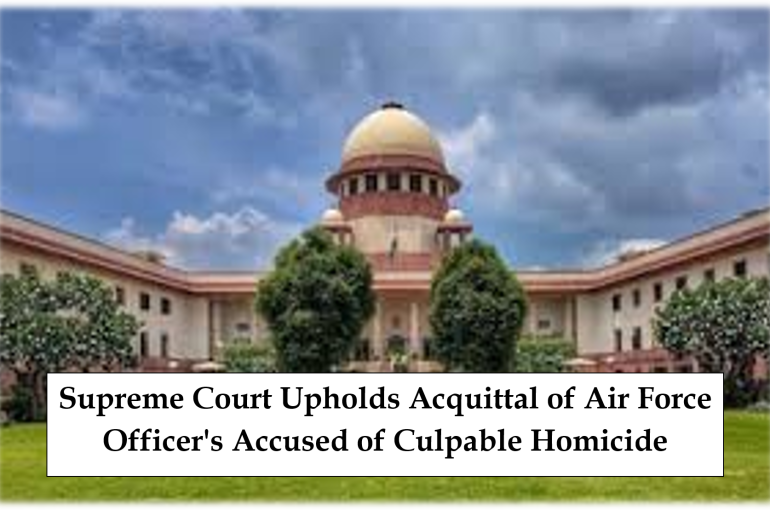Supreme Court Upholds Acquittal of Air Force Officer’s Accused of Culpable Homicide
Case Overview: In a recent ruling in Union of India & Ors. vs Wing Commander M.S. Mander (Criminal Appeal No. 190 of 2011), the Supreme Court of India upheld the Armed Forces Tribunal’s decision to acquit Wing Commander M.S. Mander, who was tried under General Court Martial (GCM) Proceedings along with four other Air Force officers. This case involved charges of culpable homicide, wrongful confinement, and various offences under the Air Force Act, 1950. The Supreme Court, Justices Abhay S. Oka and Ujjal Bhuyan, dismissed the appeal filed by the Union of India, confirming that the Tribunal’s findings were based on reasonable evidence and should not be interfered with.
Background and Charges: Wing Commander Mander and four other Air Force officers were tried by the GCM for multiple offences:
- First Charge: Offence under Section 302 of the Indian Penal Code (IPC), read with Section 149 IPC, for alleged involvement in culpable homicide.
- Alternative Charge: Direct offence under Section 302 IPC.
- Additional Charges: Offences under Sections 325 and 342 read with Section 149 IPC, along with charges under Sections 45, 65, and 71 of the Air Force Act, 1950, related to unbecoming conduct and actions prejudicial to good order.
The GCM found the Respondent and co-accused guilty of culpable homicide not amounting to murder under Section 304 Part II read with Section 149 IPC, and for wrongful confinement under Section 342 IPC. The GCM imposed a sentence of five years’ rigorous imprisonment, later reduced to two years by the Chief of the Air Staff, and ordered the cashiering of Wing Commander Mander.
Incident Details: The case involved the death of Signalman UD Garje, a serviceman who, on March 3, 1998, allegedly misbehaved with the wife of Flight Lieutenant S. Verma (accused No. 3) while repairing a telephone at their residence. Flight Lieutenant Verma reported this incident to Wing Commander Mander, who in turn reported it to the station commander. Mander instructed that Garje be brought to the Guards’ room after he failed to appear voluntarily.
On March 6, 1998, Garje was reportedly confined to a Gypsy vehicle driven by Wing Commander Mander, with Accused Nos. 2, 3, and 4 accompanying him. Garje allegedly attempted to escape from the vehicle, fell into a ditch while running, and sustained injuries that led to his death on March 7, 1998.
Arguments and Submissions:
- Prosecution’s Argument: The Union of India’s Counsel argued that the evidence presented, particularly from witnesses (PWs) 4 to 9, 27, 10, 12, 13, and 16, established the guilt of Wing Commander Mander. The Prosecution contended that the Tribunal had inadequately examined the evidence related to additional charges under the IPC and the Air Force Act. Key witnesses alleged that they had seen the Respondent involved in activities linked to Garje’s confinement and subsequent injury.
- Defence Argument: Wing Commander Mander’s Counsel argued that no direct evidence implicated him or the other Accused in physically assaulting or intentionally causing harm to Garje. The defence highlighted that the deceased’s injuries were consistent with a fall and did not indicate any assault with a weapon or blunt object. Furthermore, it was not proven that the Rpespondent had wrongfully confined Garje, as there was no concrete action restricting Garje’s movement in a deliberate manner.
Supreme Court Analysis and Findings: The Supreme Court examined the evidence presented by the Prosecution, including witness testimonies and the medical report by Dr. Shiv Kochar (PW-33), who conducted Garje’s autopsy. Key observations from the Court included:
- Medical Evidence: The autopsy showed injuries consistent with a fall. There were no fractures apart from those at the site of surgical intervention, and the injuries were found to be consistent with falling onto a concrete surface rather than assault.
- Witness Testimonies: Witnesses (PWs 7, 8, 9, 12, and 16) failed to directly connect Wing Commander Mander or other officers to any act of violence or wrongful confinement. Witness PW-8, for instance, saw Mander with a bamboo stick in the garden but did not witness any assault with it. PW-12 and PW-16, who observed events from a distance, could only describe general activity around the Gypsy vehicle but did not see any direct assault.
- Respondent’s Statement: Wing Commander Mander’s statement indicated that he initially intended to confine Garje to the Guards’ room but decided to take Garje for identification by Accused No. 3’s wife instead. The Court observed that this statement did not constitute an admission of wrongful confinement, as Garje was never actually confined.
- Legal Presumptions and Standards of Acquittal: Emphasising the established principle that an acquittal enhances the presumption of innocence, the Court noted that the Tribunal’s decision was based on plausible interpretations of the evidence. The Court held that an appeal against acquittal could not be allowed merely because an alternative interpretation of evidence was possible.
Conclusion
The Supreme Court affirmed the Armed Forces Tribunal’s judgement, concluding that the Prosecution had failed to establish intent to cause death or wrongful confinement. With no direct evidence of assault or confinement, the Supreme Court found no basis to overturn the acquittal of Wing Commander Mander. Consequently, the appeal filed by the Union of India was dismissed.
This judgement underlined the high threshold required to overturn an acquittal, particularly in cases involving charges as serious as culpable homicide and wrongful confinement. The Court’s reasoning reiterates that mere presence or circumstantial involvement without demonstrable intent or action linking to the cause of death does not satisfy the legal requirements for conviction.
Shikha
Associate
The Indian Lawyer & Allied Services





































Leave a Reply